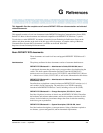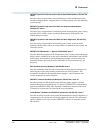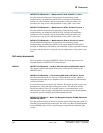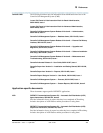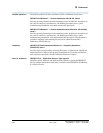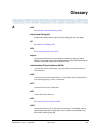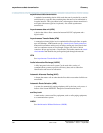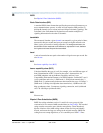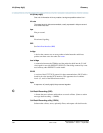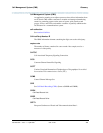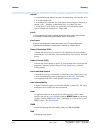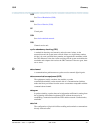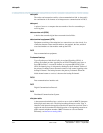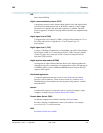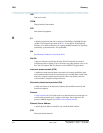
B8ZS
467
Administration for Network Connectivity
555-233-504 — Issue 1 — April 2000 CID: 77730
Glossary
B B8ZS
See Bipolar 8 Zero Substitution (B8ZS).
Basic Rate Interface (BRI)
A standard ISDN frame format that specifies the protocol used between two or
more communications systems. As used in North America, BRI provides 23
64-kbps B-channels (voice or data) and one 64-kbps D-channel (signaling). The
D-channel is the 24th channel of the interface and contains multiplexed
signaling information for the other 23 channels.
bandwidth
The amount of data that a given channel can transmit in a given period of time,
measured in bits per second (not bytes per second) on digital networks or in
Hertz (cycles per second) on analog networks.
For analog transmission, the
band width can be measured as the difference, expressed in hertz, between
the highest and lowest frequencies transmitted.
baud
A unit of transmission rate equal to the number of signal events per second. See
also bit rate.
BCC
See bearer capability class (BCC)
bearer capability class (BCC)
Code that identifies the type of a call (for example, voice and different types of
data). Determination of BCC is based on the caller’s characteristics for
non-ISDN endpoints and on the Bearer Capability and Low-Layer
Compatibility Information Elements of an ISDN endpoint. Current BCCs are 0
(voice-grade data and voice), 1 (DMI mode 1, 56 kbps data transmission), 2
(DMI mode 2, synchronous/asynchronous data transmission up to 19.2 kbps) 3
(DMI mode 3, 64 kbps circuit/packet data transmission), 4 (DMI mode 0, 64
kbps synchronous data), 5 (temporary signaling connection, and 6 (wideband
call, 128–1984 kbps synchronous data).
BER
Bit error rate.
Bipolar 8 Zero Substitution (B8ZS)
B8ZS line coding substitutes a mix of 1s and 0s for every group of eight
consecutive 0s in a stream of AMI-encoded data (see line coding). The encoded
string contains consecutive ones with the same polarity. These intentional,
bipolar violations of the AMI coding scheme let the receiving end identify,
decode, and restore the long zero strings in the original message. B8ZS line
coding does not corrupt digital data, so it is commonly used with T-1 lines.



